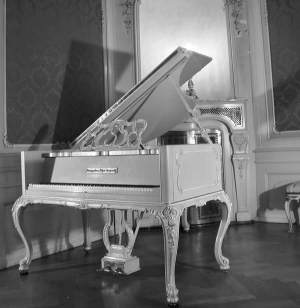|
Editorial Board
Melanie
Eskenazi
Webmaster: Len Mullenger
|
Seen and Heard Recital Review
Liszt and Wagner: Thomas Hitzlberger (piano) St John’s, Smith Square, 25.01. 2007 (JPr)
Sonata in B minor
The last time I ever saw a piano of such
ornate splendour being played (it was all pale yellow and ivory white, the
pictures I have found cannot do it justice) there was a candelabra on top of it.
The pianist’s name was …
Wladziu Valentino Liberace As I was researching the piano I discovered that Mark son’s Pianos were managing the logistics for this concert for the concert’s promoters, Ambronay Cultural Centre with the French Music Export Bureau, and this involved the transportation, technical setup, and the tuning of this very historic instrument. Anybody interested might like to know that Steingraeber are allowing them to exhibit this piano at their Regent’s Park showroom from 23 to 30 January 2007. As their website suggested this is ‘A real opportunity NOT to be missed by piano enthusiasts’. In fact more people may get to see it that were present at St John’s, Smith Square. I have not been there for years but from bitter experience (having put on events there myself) I cannot see the point of this venue. It is okay if the event has a ready made audience such as a big name, a loyal following or a Christmas Messiah but evenings like this that deserve large numbers draw the standard St John’s crowd of about 200, if that. Liszt’s music that Hitzlberger played essentially told strong stories from Dante’s Inferno, to the songs without the words of Das Buch der Lieder and lastly the Faustian Sonata. The piano was ideal for such story telling, with a clear dynamic between the upper and lower piano registers. There was a clarity of sound that was natural, elsewhere described as ‘earthy’, that gelled well with Hitzlberger’s gung-ho expressive technique that drew as much emotion, violent or passionate, or eloquence as he could from the technically challenging music. The piano lent an air of theatricality to the recital that the pianist ‘conducting’ with his left hand of quieter, dextrous right-hand passages did little to dispel. Modern instruments would even everything out, and a concert Steinway could only make it sound more mechanical in comparison. The best way I could described how ‘real’ it all sound, despite all reality being a form of artifice, is that I continuously thought of the piano accompaniment to silent black and white films, yet this time the images were only in my head and heart. On this piano I am sure it is therefore possible to conjure up the spirit of the composer and the sound of the music as he would have played it (and heard it) even if it is not however possible to recreate Liszt’s unique interpretation of his own compositions. Mind you it all took a while to settle down, initially overzealous pedalling sent reverberations through the wooden staging and endangered the eardrums but it soon settled down and a judicious use of St John’s, Smith Square’s monthly diaries, folded and put under each leg of the piano made for an even more balanced sound after the interval. Unfortunately the Liebestod transcription was before the break and was, for me, the least successful piece played, lacking the radiance (despite the piano’s bright sound) and all-embracing transfiguration this music can have even just on the piano. Nevertheless hearing this music on this instrument can only underline what Wagner admitted in a letter to Hans von Bülow that ‘since I became acquainted with Liszt’s compositions I have become a quite different fellow in my harmonic writing’. The debt that Wagner’s musical language from Tristan onwards has never been more clearly illustrated than by this recital.
Jim Pritchard
Back to the Top Back to the Index Page |
| ||
|
||||



